Humidity-Controlling Ceramic Bricks: Enhancing Evaporative Cooling Efficiency to Mitigate Urban Heat Island Effect
Abstract
:1. Introduction
2. Materials and Methods
2.1. Raw Materials
2.2. Preparation of HCCTs
2.3. Experimental Methods
2.3.1. Flexural Strength and Water Absorption Tests
2.3.2. Pore Structure Test
2.3.3. Microstructural Analysis
2.3.4. Evaporation Performance Test
2.4. Numerical Simulation
2.4.1. Model Foundation
2.4.2. Governing Equations
2.4.3. Boundary Conditions
3. Results and Discussion
3.1. Flexural Strength and Water Absorption
3.2. Impact of Glaze Quantity
3.3. Hygrothermal Properties
3.3.1. Water Absorption Profile
3.3.2. Evaporation Profile
3.3.3. Temperature Profile
3.4. Numerical Calculation of Heat and Moisture Transfer Process in HCCTs
3.4.1. Validation Model
3.4.2. Factors Influencing Heat and Moisture Transfer of HCCTs
- (1)
- Volumetric water content
- (2)
- Porosity
- (3)
- Thickness
4. Conclusions
Author Contributions
Funding
Data Availability Statement
Conflicts of Interest
References
- Maka, A.O.; Alabid, J.M. Solar energy technology and its roles in sustainable development. Clean Energy 2022, 6, 476–483. [Google Scholar] [CrossRef]
- Zhang, L.; Zhang, R.; Zhang, Y.; Hong, T.; Meng, Q.; Feng, Y. The impact of evaporation from porous tile on roof thermal performance: A case study of Guangzhou’s climatic conditions. Energy Build. 2017, 136, 161–172. [Google Scholar] [CrossRef]
- Wang, J.; Meng, Q.; Yang, C.; Ren, P.; Santamouris, M. Spray optimization to enhance the cooling performance of transparent roofs in hot-humid areas. Energy Build. 2023, 286, 112929. [Google Scholar] [CrossRef]
- Zhang, Y.; Zhang, L.; Pan, Z.; Meng, Q.; Feng, Y.; Chen, Y. Hydrological properties and solar evaporative cooling performance of porous clay tiles. Constr. Build. Mater. 2017, 151, 9–17. [Google Scholar] [CrossRef]
- Li, L.; Xu, F.; Tang, H.; Wang, J.; Meng, Q. Experimental and theoretical study on cooling performance of membrane roof with circulated water film. Constr. Build. Mater. 2023, 403, 133115. [Google Scholar] [CrossRef]
- Zhang, L.; Zhang, R.; Hong, T.; Zhang, Y.; Meng, Q. Impact of post-rainfall evaporation from porous roof tiles on building cooling load in subtropical China. Appl. Therm. Eng. 2018, 142, 391–400. [Google Scholar] [CrossRef]
- Mao, H.; Meng, Q.; Liu, Z.; Wang, S.; Wang, J. A comprehensive evaluation of water spray system on transparent roof towards optimal operation schedule. Build. Environ. 2023, 242, 110590. [Google Scholar] [CrossRef]
- He, J.; Hoyano, A. Experimental study of practical applications of a passive evaporative cooling wall with high water soaking-up ability. Build. Environ. 2011, 46, 98–108. [Google Scholar] [CrossRef]
- He, J.; Hoyano, A. Experimental study of cooling effects of a passive evaporative cooling wall constructed of porous ceramics with high water soaking-up ability. Build. Environ. 2010, 45, 461–472. [Google Scholar] [CrossRef]
- Hall, M.R. Assessing the environmental performance of stabilised rammed earth walls using a climatic simulation chamber. Build. Environ. 2007, 42, 139–145. [Google Scholar] [CrossRef]
- Zhang, Y.; Zhang, L.; Meng, Q.; Feng, Y.; Chen, Y. A dynamic experimental study on the evaporative cooling performance of porous building materials. Heat Mass Transf. 2017, 53, 2651–2662. [Google Scholar] [CrossRef]
- Pan, Z.; Meng, Q.; Li, Q.; Xie, J.; Liu, J. Evaporative cooling of porous tiles with seawater in a tropical climate with salty humid air. Constr. Build. Mater. 2019, 204, 727–739. [Google Scholar] [CrossRef]
- Wang, J.; Santamouris, M.; Meng, Q.; He, B.-J.; Zhang, L.; Zhang, Y. Predicting the solar evaporative cooling performance of pervious materials based on hygrothermal properties. Sol. Energy 2019, 191, 311–322. [Google Scholar] [CrossRef]
- Tian, W.; Shui, A.; Ke, S.; Huang, L.; Xi, X.; He, C.; Chen, W.; Du, B. Low-temperature preparation of humidity self-regulating porous ceramics with high strength performance. Mater. Lett. 2019, 243, 128–131. [Google Scholar] [CrossRef]
- Dal, S.; Sutcu, M.; Gok, M.S.; Gencel, O. Characteristics of lightweight diatomite-based insulating firebricks. J. Korean Ceram. Soc. 2020, 57, 184–191. [Google Scholar] [CrossRef]
- Vu, D.-H.; Wang, K.-S.; Bac, B.H. Humidity control porous ceramics prepared from waste and porous materials. Mater. Lett. 2011, 65, 940–943. [Google Scholar] [CrossRef]
- Tian, W.; Du, B.; Shui, A.; Ke, S.; Shan, Q.; He, C.; Ma, J. Template-free preparation of humidity self-regulating silica-based mesoporous oxide from volcanic ash. J. Sol-Gel Sci. Technol. 2020, 94, 416–424. [Google Scholar] [CrossRef]
- ASTM C78/C78M-2015a; Standard Test Method for Flexural Strength of Concrete (Using Simple Beam with Third-Point Loading). ASTM: West Conshohocken, PA, USA, 2015.
- ASTM C1585e13; Standard Test Method for Measurement of Rate of Absorption of Water by Hydraulic-Cement Concretes. ASTM: West Conshohocken, PA, USA, 2013.
- JGJ 286-2013; Design Standard for Thermal Environment of Urban Residential Areas. Ministry of Housing and Urban-Rural Development: Beijing, China, 2013.
- Black, L.; Stumm, A.; Garbev, K.; Stemmermann, P.; Hallam, K.R.; Allen, G.C. X-ray photoelectron spectroscopy of aluminium-substituted tobermorite. Cem. Concr. Res. 2005, 35, 51–55. [Google Scholar] [CrossRef]
- GB/T 4100-2015; Ceramic Tiles. China National Standardization Administration: Beijing, China, 2015.
- JC/T 2082-2011; Humidification Function Interior Building Decoration Materials. Ministry of Science and Technology of the People’s Republic of China: Beijing, China, 2011.
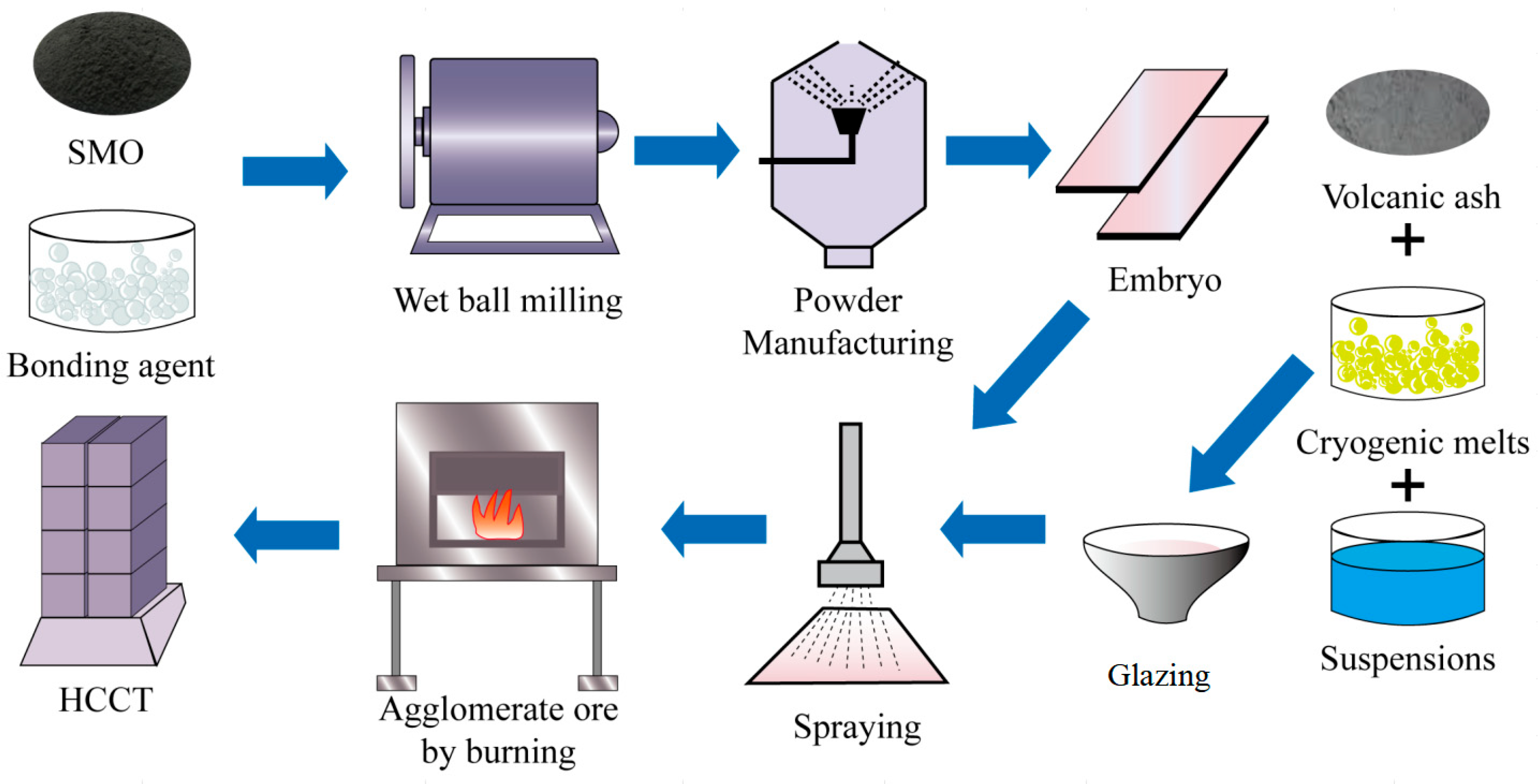

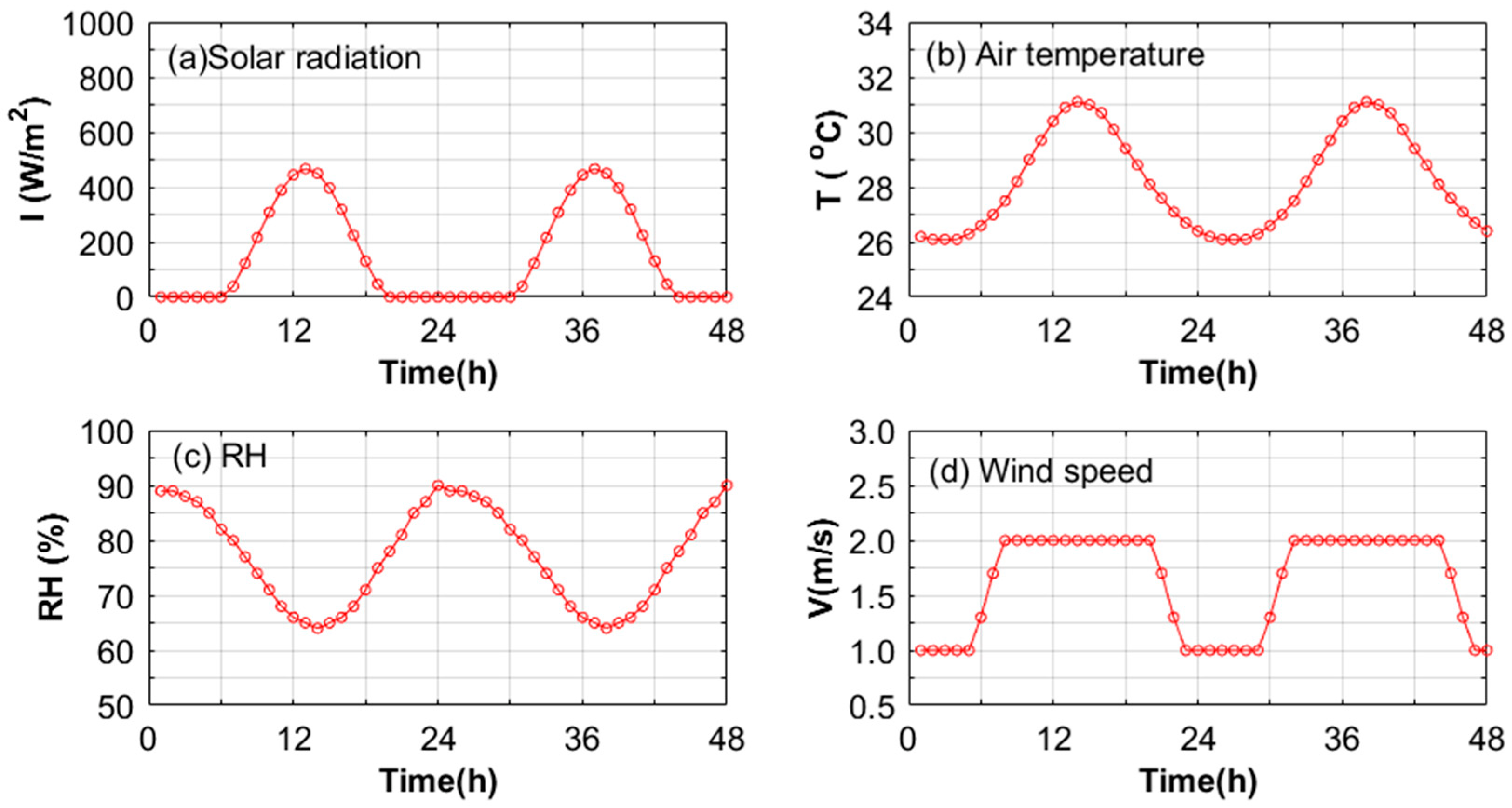


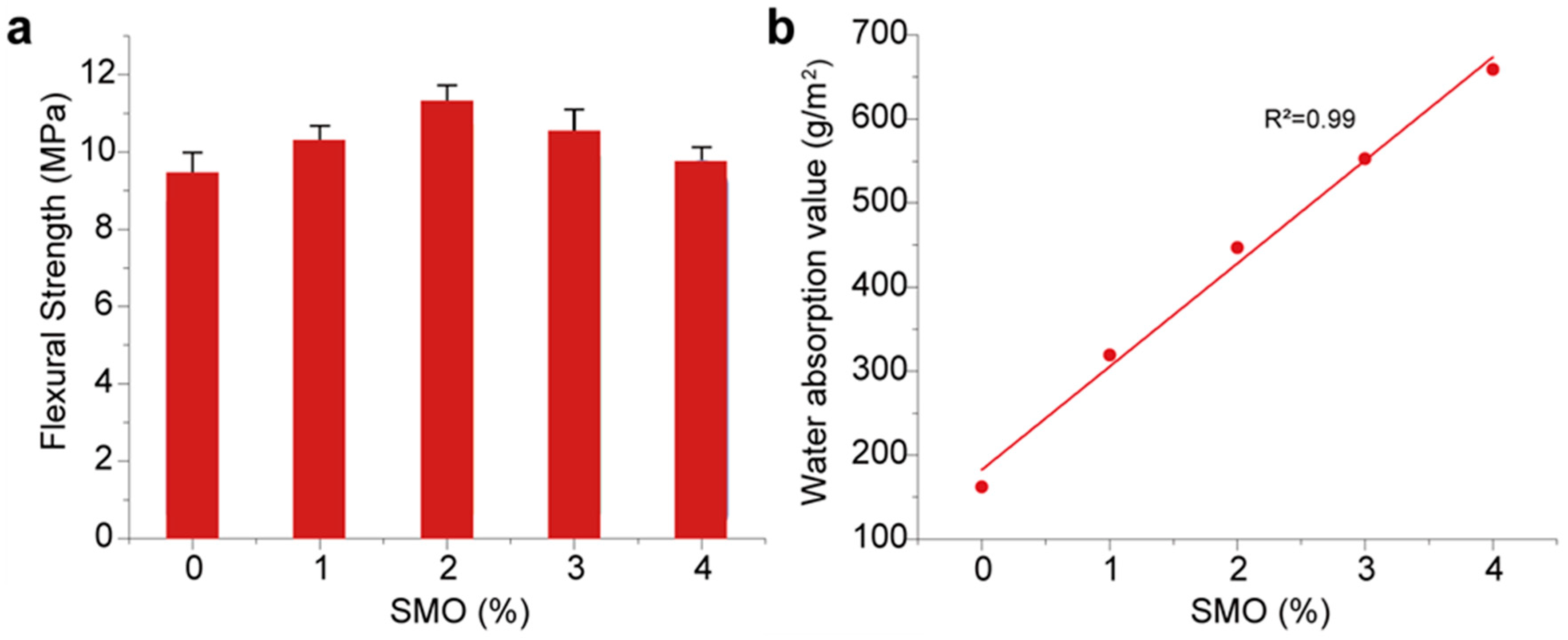
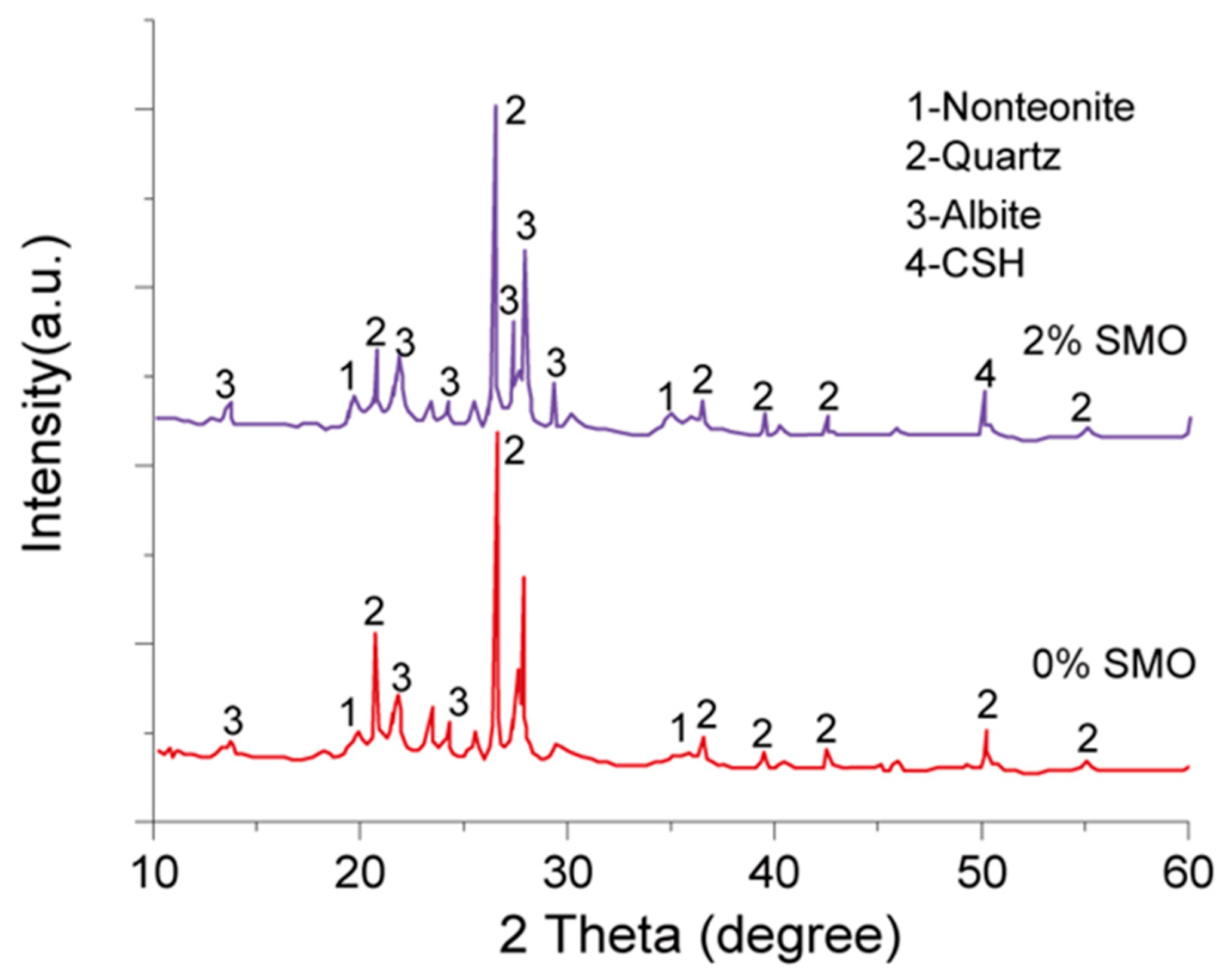
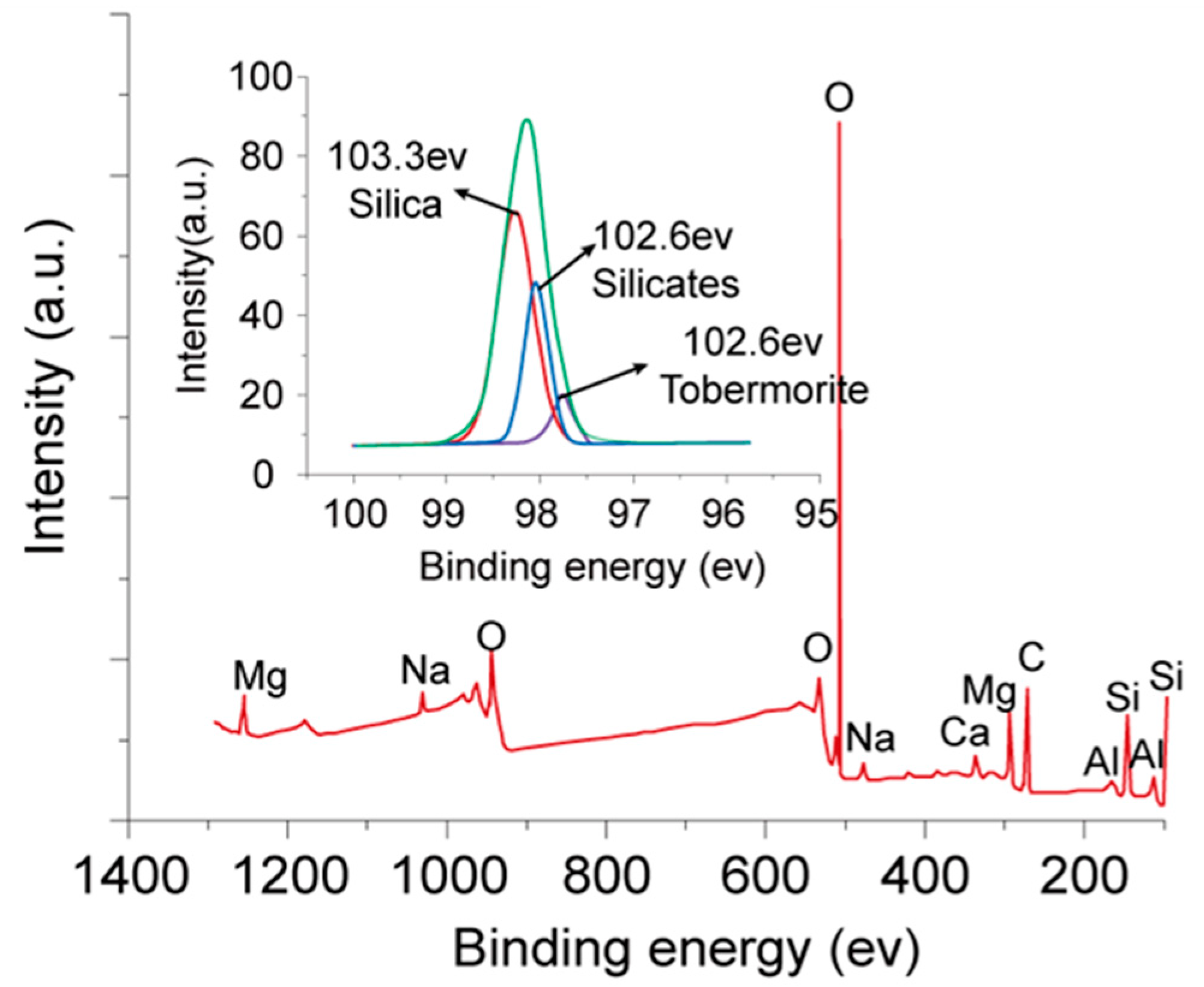
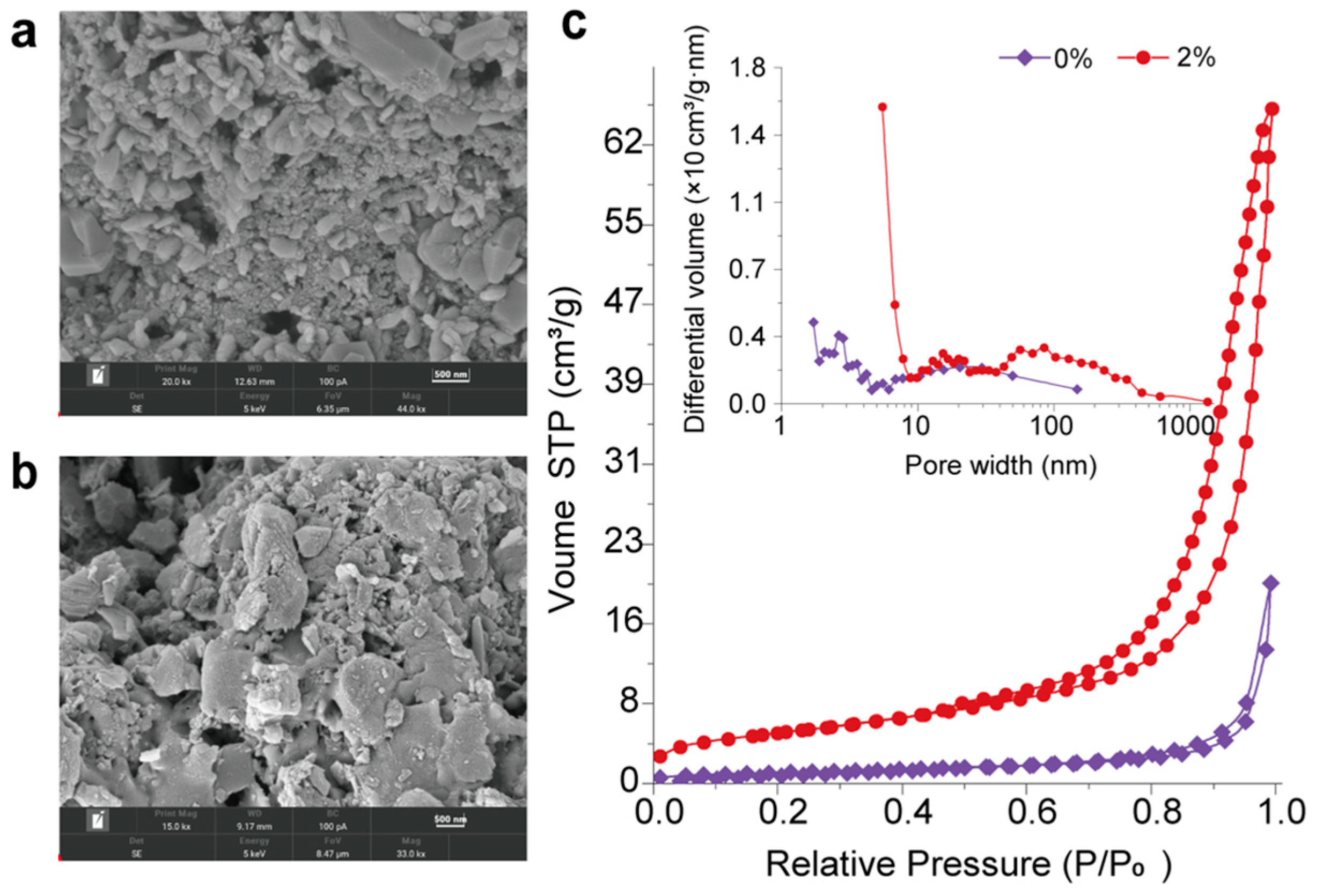
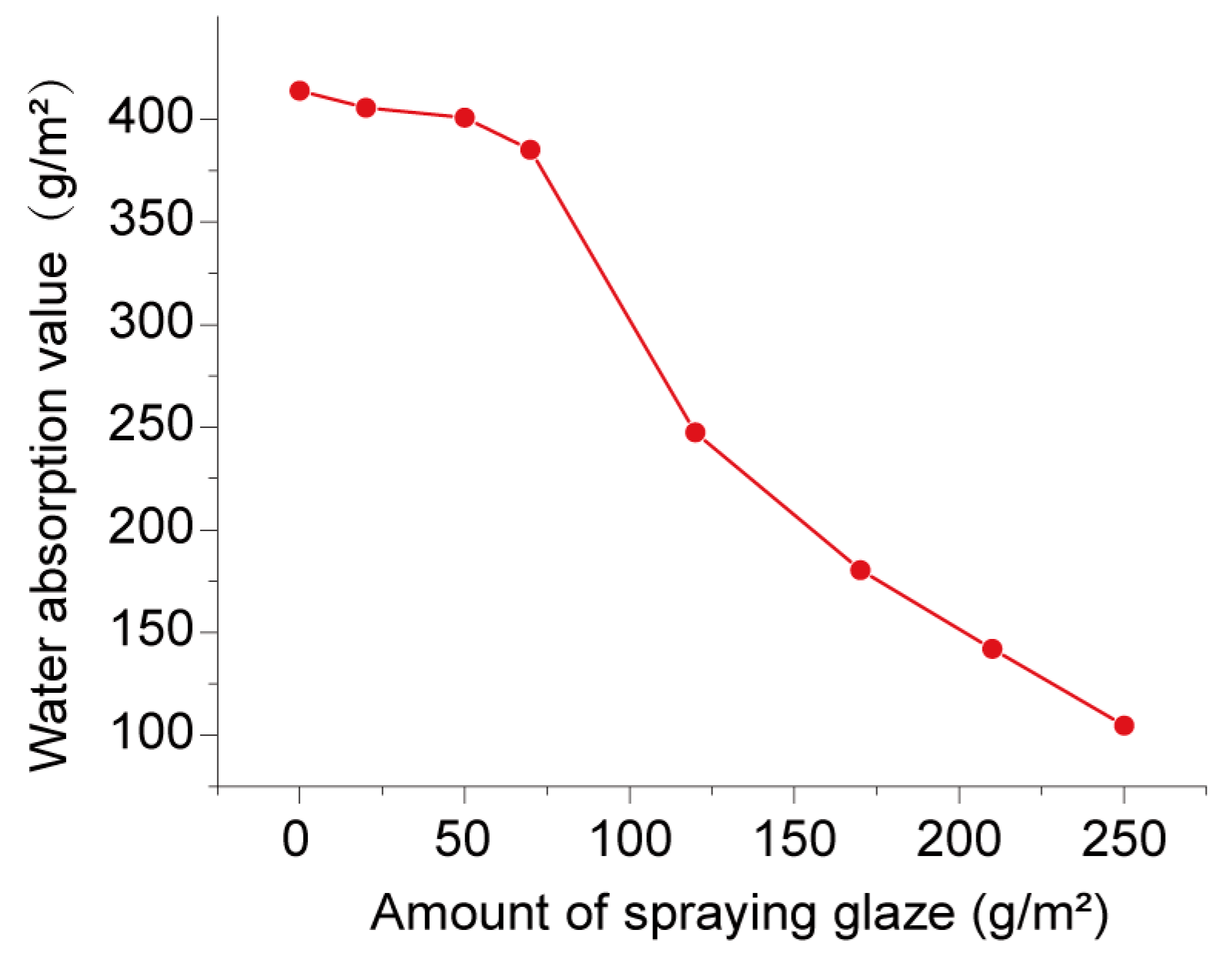
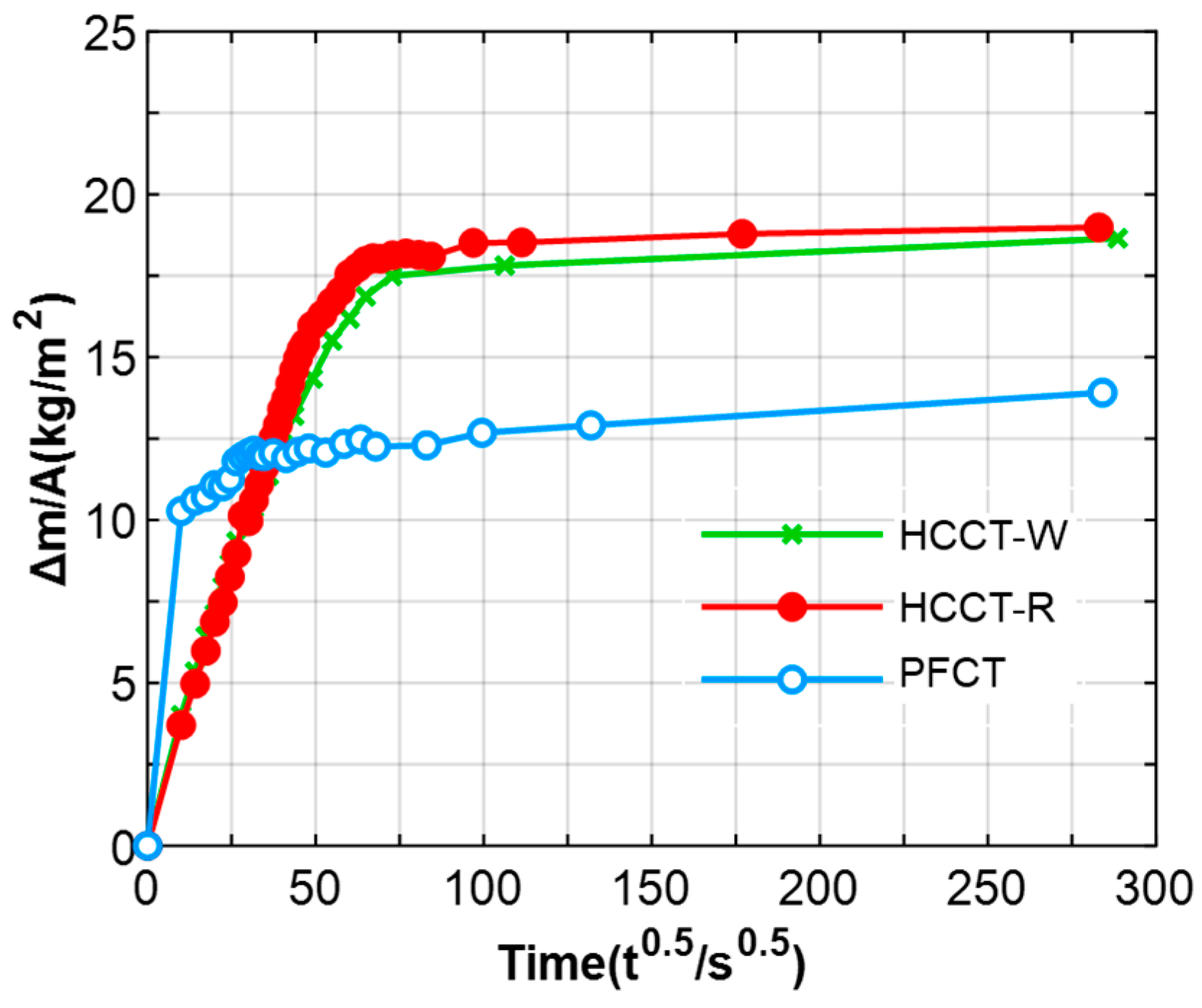
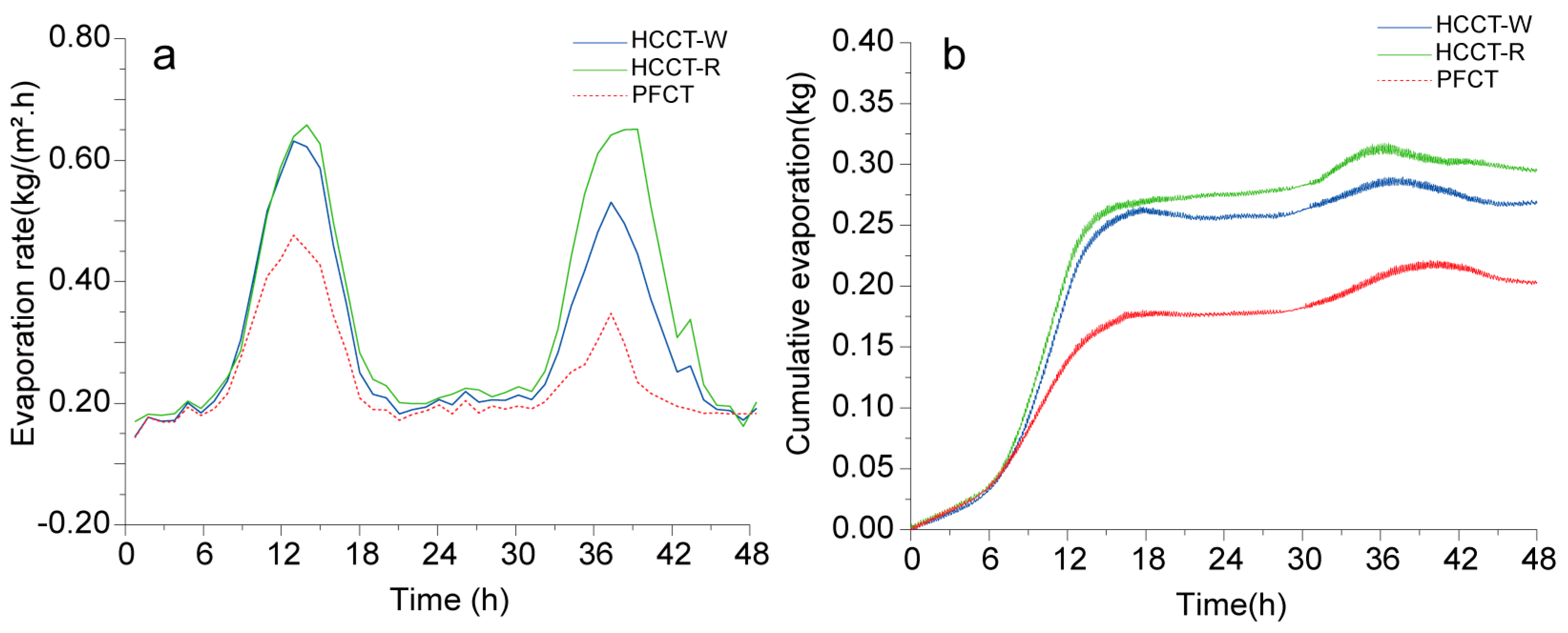
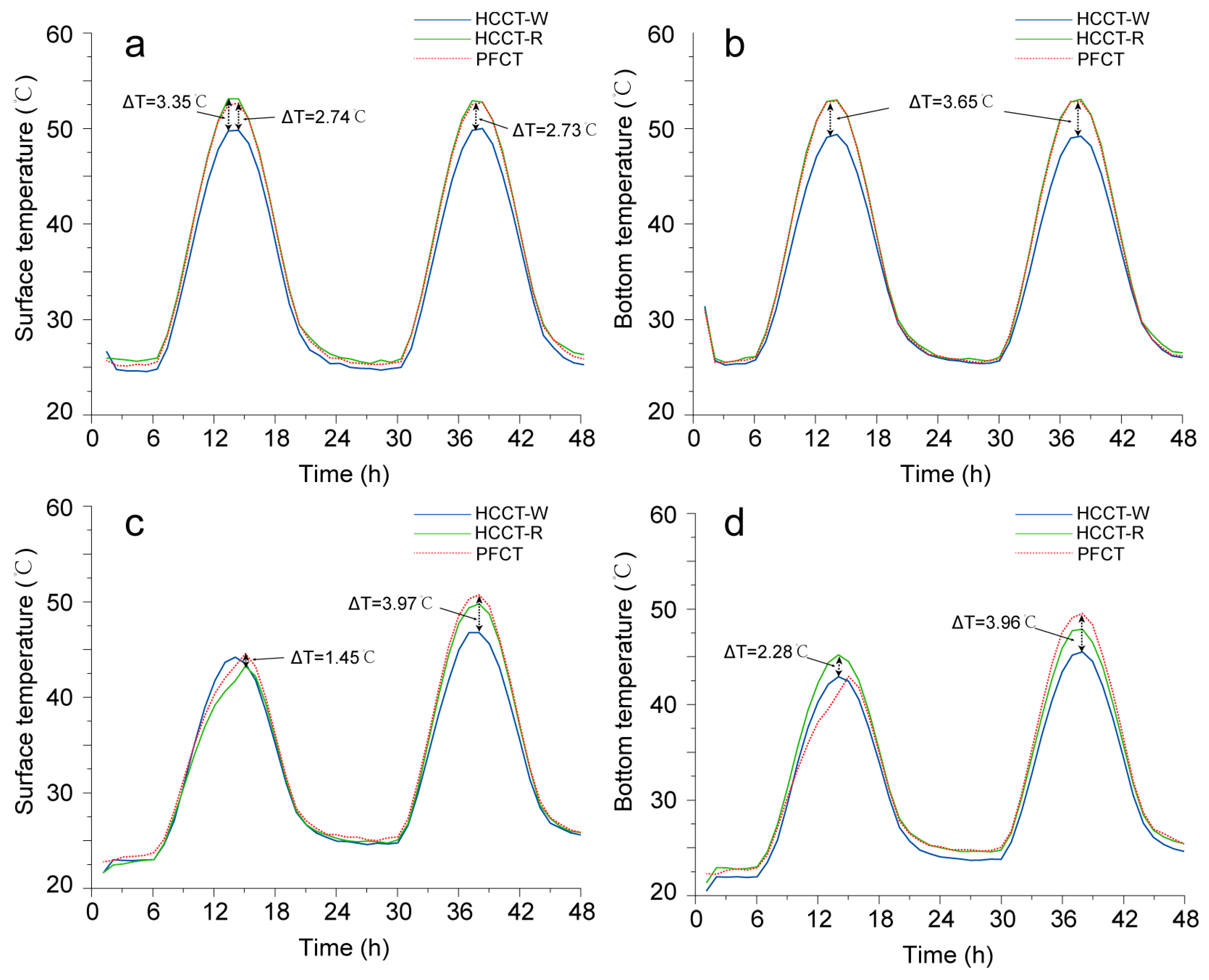
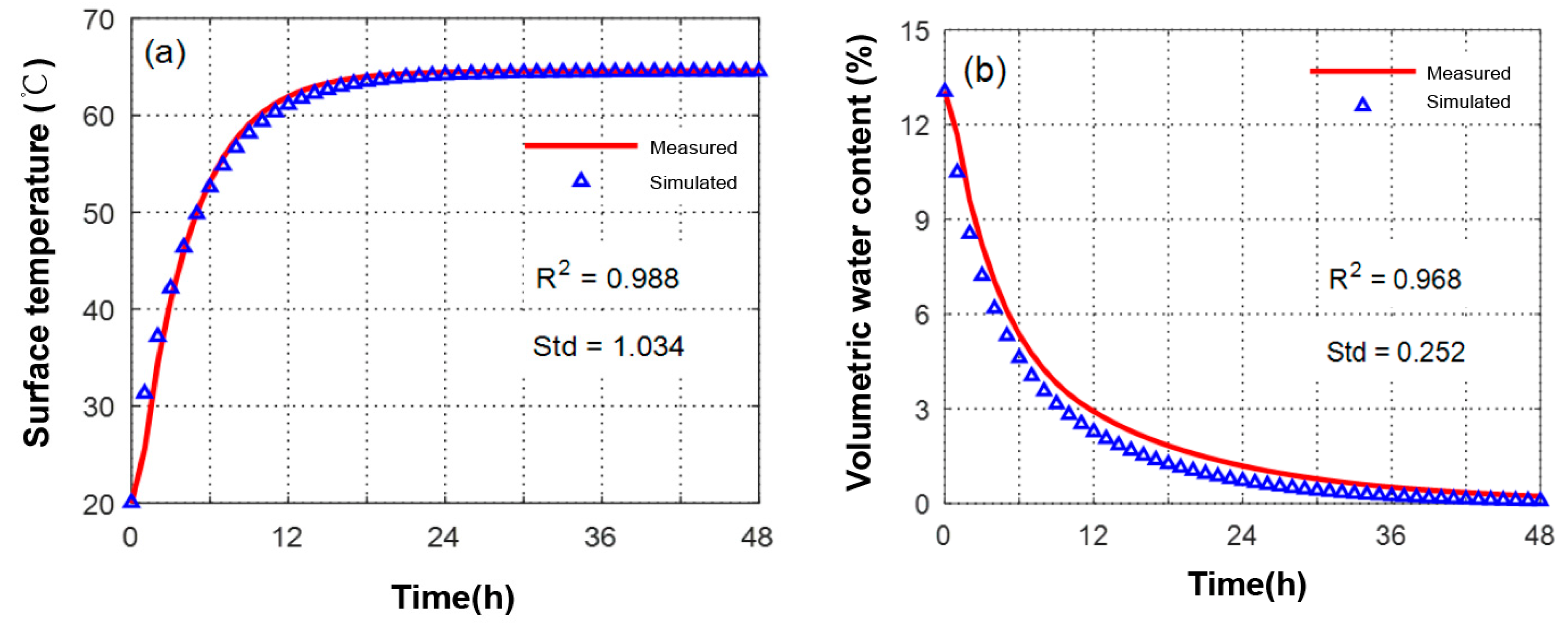
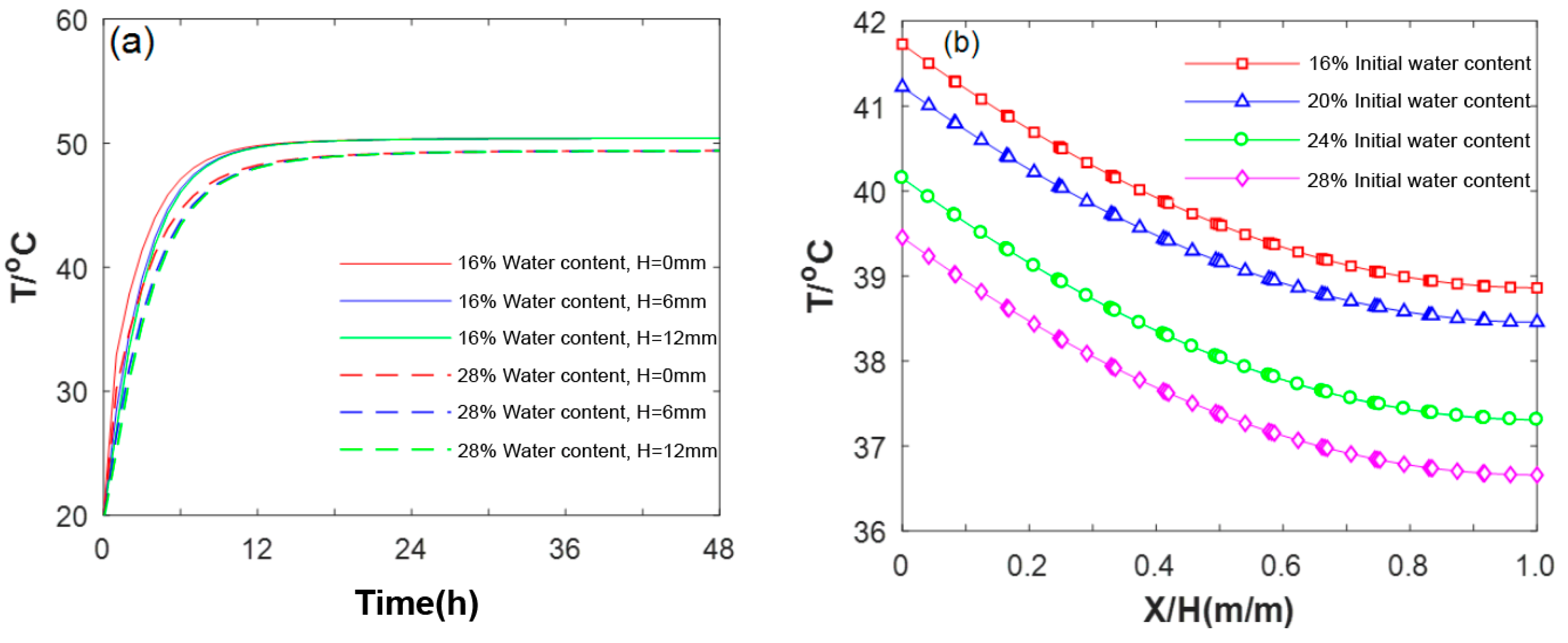

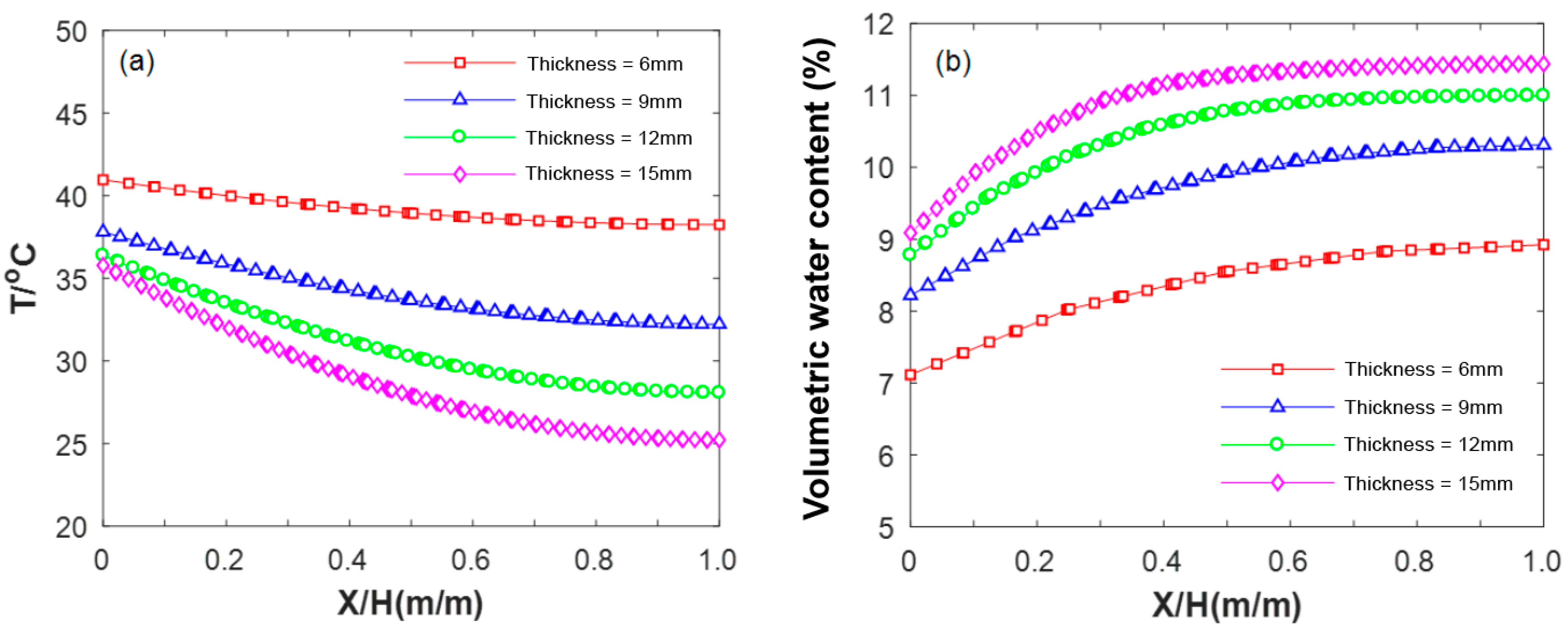
| Materials | SiO2 | Al2O3 | Fe2O3 | TiO2 | CaO | MgO | K2O | Na2O |
|---|---|---|---|---|---|---|---|---|
| Volcanic powder | 67.92 | 12.44 | 1.12 | 0.15 | 3.14 | 4.12 | 0.43 | 1.15 |
| Potassium–sodium powder | 72.43 | 13.38 | 0.06 | 0.08 | 0.43 | 0.01 | 8.06 | 5.29 |
| Low-temperature melt | 27.32 | 1.05 | 0.13 | 3.12 | 3.45 | 1.12 | 2.89 | 11.63 |
| SMO | 91.11 | 1.92 | 0.08 | 0.14 | 0.5 | 0.01 | 0.28 | 0.22 |
| Material | Thickness (mm) | Density (kg/m3) | Heat Capacity (J/(kg·K)) | Thermal Conductivity (W(m·°C)) | Porosity (%) |
|---|---|---|---|---|---|
| HCCT | 12 | 1700 | 900 | 1.5 | 20 |
| Material | S1 (×10−2 mm/s0.5) | S2 (×10−2 mm/s0.5) | Wvap (kg/m3) | Open Porosity (%) | ||||
|---|---|---|---|---|---|---|---|---|
| Mean | SD* | Mean | SD* | Mean | SD* | Mean | SD* | |
| PFCT | 4.92 | 0.251 | 0.04 | 0.034 | 130.85 | 4.205 | 35.05 | 0.124 |
| HCCT-W | 3.69 | 0.312 | 0.07 | 0.052 | 173.39 | 5.031 | 36.98 | 0.261 |
| HCCT-R | 3.65 | 0.123 | 0.07 | 0.047 | 177.41 | 4.936 | 36.24 | 0.173 |
Disclaimer/Publisher’s Note: The statements, opinions and data contained in all publications are solely those of the individual author(s) and contributor(s) and not of MDPI and/or the editor(s). MDPI and/or the editor(s) disclaim responsibility for any injury to people or property resulting from any ideas, methods, instructions or products referred to in the content. |
© 2024 by the authors. Licensee MDPI, Basel, Switzerland. This article is an open access article distributed under the terms and conditions of the Creative Commons Attribution (CC BY) license (https://creativecommons.org/licenses/by/4.0/).
Share and Cite
Jin, X.; Wang, J.; Tan, K.; Zou, Z. Humidity-Controlling Ceramic Bricks: Enhancing Evaporative Cooling Efficiency to Mitigate Urban Heat Island Effect. Atmosphere 2024, 15, 964. https://doi.org/10.3390/atmos15080964
Jin X, Wang J, Tan K, Zou Z. Humidity-Controlling Ceramic Bricks: Enhancing Evaporative Cooling Efficiency to Mitigate Urban Heat Island Effect. Atmosphere. 2024; 15(8):964. https://doi.org/10.3390/atmos15080964
Chicago/Turabian StyleJin, Xueli, Junsong Wang, Kanghao Tan, and Zhenjie Zou. 2024. "Humidity-Controlling Ceramic Bricks: Enhancing Evaporative Cooling Efficiency to Mitigate Urban Heat Island Effect" Atmosphere 15, no. 8: 964. https://doi.org/10.3390/atmos15080964









